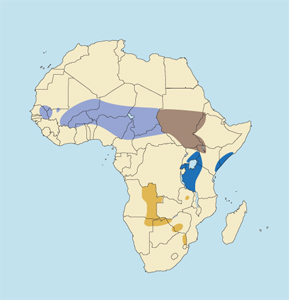 |
 |
Damaliscus lunatus korrigum
Bubalo de Senegal (Sp), Leierantilope (G), Damalisque (F). Also called Senegal hartebeest, but korrigum, its local name in West Africa, is a better choice, as the animal is a damalisc, not a hartebeest, and is found in many countries besides Senegal (where it may now be extinct.) Sometimes called giant topi.
DESCRIPTION Shoulder height 50-52 inches (127-132 cm). Weight 270-300 pounds (122-136 kg).
The korrigum is the largest of the topi group (topi, tiang and korrigum) and grows the largest horns. Its general color is a bright reddish orange. The bluish black patches on shoulders, hips and upper legs are less extensive than in the tiang or topi, and the lower legs are much the same color as the body. The bluish black face blaze has a narrow streak running from it below and behind the eye. The tail is fairly short, barely reaching the hocks, with a crest of black hairs on the lower third. The horns (both sexes) are thick, rather short, strongly ringed and lyrate. They rise in a gentle backward curve, diverging slightly, then turning slightly upward at the tips.
BEHAVIOR Highly gregarious, it lives in herds of 15-30, sometimes hundreds, or even thousands during seasonal migrations in search of new grass during the early rains. Often mingles with other species such as zebra, wildebeest and hartebeest. Breeding males are territorial during the rut, each defending a well-marked "stamping ground" against other males, through which females and juveniles wander freely. After the rut the herds split, with males and females forming groups by themselves.
Exclusively a grazer, able to thrive on dry grasses not eaten by other antelopes. Drinks water, but is able to go without it for long periods. Eyesight, hearing and sense of smell are good. A very fast runner, probably as swift as the tsessebe.
HABITAT Grasslands and savanna woodlands, sometimes in arid country.
DISTRIBUTION From Senegal eastward to southern Chad and the northern Central African Republic.
TAXONOMIC NOTES This category includes three listed subspecies: korrigum (Senegal to northern Nigeria), lyra (southern Chad and northern C.A.R.) and purpurescens (Nigeria and northern Cameroon), with korrigum Ogilby, 1837 having priority.
|





